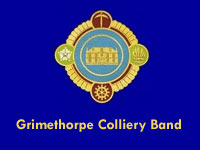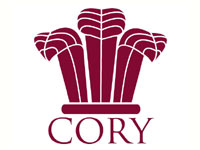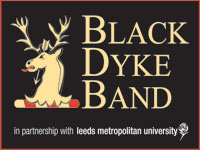British Open Gala Concert
17-Sep-2009Grimethorpe Colliery (Alan Withington); Hemsworth Arts and Community College (Julian Laraunte); Cory (Robert Childs); Black Dyke (Nicholas Childs)
Symphony Hall, Birmingham
Sunday 13th September
Over the past few years the Sunday concert following the British Open has gained a reputation for providing an afternoon full of contrasts and quality, played by first class bands.
This year, courtesy of the three adjudicators, the bands participating had occupied the first three places the previous day, so the expectations of the near-capacity audience (including Hermann Pallhuber, the composer of Saturday’s test-piece) were high.
 Grimethorpe - Now for something completely different
Grimethorpe - Now for something completely different
The first band on stage was Grimethorpe, and it was clear that, in the words beloved of Monty Python fans, the audience was in for “something completely different”.
Alan Withington had devised a tribute to the family von Trapp, featuring both the band and some very talented youngsters from Hemsworth Arts and Community college, who provided the seven von Trapp children – all girls, this time – as well as an enthusiastic chorus.
There was also a very personable narrator (un-credited, unfortunately) who guided the audience through the story of Maria and the retired sea captain.
Setting the scene
It was an ingenious format, which enabled the band to feature a number of well-known melodies, as well as a number of the Rodgers and Hammerstein tunes from “The Sound of Music”.
The band opened with a characterful reading of Walter Hargreaves’s arrangement of “On the Beautiful Blue Danube” (Johann Strauss II), during which the children made their entrance, each portraying a different personality trait – one curious, one tripping over herself, one dancing, one showing off, one marching etc.
Howard Snell’s delicate setting of the “Air from the Third Suite” (Johann Sebastian Bach) served to illustrate the young Maria being inspired by a notable preacher, and featured some sublime playing from the band’s horn section.
Exceptional soprano playing
This was followed by one of the highlights of the afternoon, with Kevin Crockford rising to his feet to play the “Intermezzo from Cavalleria Rusticana” (Mascagni arr Denis Wright), soaring seemingly effortlessly above the band and earning a warm ovation from the audience.
The narrator explained how Maria had entered the convent, but had become unwell as she felt confined and missed the open air, hence the decision to send her to help Captain von Trapp with one of his children who had a fever: cue Richard Rodgers’ “Lonely Goatherd”, during which the chorus entered, winding their way through the body of the hall before taking their places standing behind the band.
Robert Westacott had his chance to shine with an ascending D major scale (concert), and then came a bit of audience participation, as various sections of the hall were allocated the notes for “Doh, re, mi”, singing along with the children on stage, as the girl singing “Doh” darted from one end of the row to the other to sing in successive octaves.
Wedding celebration
Mention of the wedding of Maria and the Captain gave the opportunity for the band to produce a real organ-like sound in the “Wedding March from A Midsummer Night’s Dream” (Mendelssohn arr Steven Sykes), whilst the reference to opposing the Nazi regime brought an extract from the “Luftwaffe March” from “Battle of Britain” (Ron Goodwin), the flight from Austria being illustrated by a few bars of Rossini’s “Tarantella”.
Witty and subtle
The presentation concluded with a sequence of songs from the musical, including “My Favourite Things”, “16 going on 17”, “So long, Farewell”, a reprise of “Doh a deer”, “Edelweiss” and “How do you solve a problem like Maria?”.
The arrangements were subtle and witty, placing considerable demands on the players whilst never swamping the singers: indeed Kevin Crockford may have felt at times that he was back playing the test piece, as he was called upon to rise up above the stave once more.
After the positive affirmation of “Climb every Mountain” the band turned once more to Johann Strauss and the “Radetzky March” as the performers took their curtain calls.
It was a most successful opening to the afternoon, with the band in fine form, and it is clear that a lot of work had gone into it, both from band, actors and singers.
What could have been seen as something of a gimmick was in fact a very successful venture, both in terms of music and presentation.
 Cory – Hail the Dragon
Cory – Hail the Dragon
As is often the case, it fell to Cory to present the majority of the new music of the afternoon.
There was a cheer as the Open trophy was brought to the stage and they launched into Philip Sparke’s “Hail the Dragon”, commissioned as part of their 125th anniversary celebrations. After the opening fanfare and dance-like figures there was the opportunity to savour the lyrical playing of Principal Cornet Ian Williams and solo horn Owen Farr, as well as some effective, quiet, muted passages from cornets and trombones.
As the music built to a climax a quotation from the composer’s own “Year of the Dragon”, also written for the Cory Band, cut through the texture.
Welsh heritage
Another new work marking their anniversary is Gareth Wood’s “Brass Triumphant”, celebrating the band’s Welsh heritage.
Three of the four movements were presented, commencing with a fanfare to “Ton Temperance”, the band’s original name, the music looking back to the writing of former times, with strong dynamic contrasts and effective writing for the band’s fine trombone section: a homage to the past but with a modern twist.
The following movement, featuring the smooth euphonium of David Childs, depicted the mist-shrouded 'Afan Valley', and was also marked by expressive playing around the stand, not least the delicate pianissimo at the close.
The finale was something of a tour de force with technical challenges for the whole band, including the four-strong percussion section, and crisp, rhythmic playing throughout.
Moonbeams on the water
Flugel player Joanne Childs was the soloist in Dan Price’s “Moonbeams”, a two-part composition in song and dance form, but not following a specific programme.
Quiet, sustained chords and delicate arpeggio figures, coloured by the vibraphone of Gavin Pritchard, supported the fluid solo line. Joanne seemed totally relaxed throughout the interplay between the soloist and horn, trombone and cornets respectively.
With the jig-like rhythms of the second part, it was easy to picture the moonbeams dancing on the water, with phrases tripping lightly off the tongue, both soloist and band displaying a light, delicate touch.
Tribute to greats of the past
Cory commissioned “On the Shoulders of Giants” from Peter Graham as their Own Choice work for the European Brass Band Championships in 2009.
“Giants” is a concert reduction, featuring elements from the First Movement, with its tribute to Bruckner and the Chicago Symphony Orchestra Brass, and the Third , alluding to the soloists of John Philip Sousa’s band.
The lower part of the band produced a massive sound at the opening, and the fanfares seemed to look back to the Mahler references of the previous day. There was some very smooth playing throughout the ensemble, with well-controlled crescendi.
A passage for xylophone and horns reminded the listener of Peter Graham’s own “Shine as the Light”, whilst the soprano cornet of Bert van Theinen rang out clearly.
Solo features for cornet, trombone and euphonium played tribute to Herbert Clarke, Arthur Pryor and Simone Mantia respectively, and there was some extremely neat piano passagework from baritones and basses, although in the absence of the central “Jazz” movement it did seem to be lacking something structurally.
Encore!
Cory’s had programmed an encore, as may have been surmised by the presence of a drum-kit, hitherto unused, in front of the band. “Sing, Sing, Sing” (Prima, arr Price) had formed a key element of their winning programme at Brass in Concert 2008, and this rendition was repeated, complete with three percussionists in Blues Brothers’ outfits, tapping out a routine on bar stools.
It made for an uplifting finale, with special mention for Chris Thomas’s trombone solo and Bert’s excursions into the stratosphere above the band.
 Black Dyke
Black Dyke
Following an interval, during which sufficient chairs had been set out for the massed band finale, Black Dyke took their places.
Fresh from a successful visit “Down-Under” they commenced with a refined, detailed reading of William Rimmer’s march “The Australasian”, with tasteful contributions from soprano, solo cornet and rep, and telling work from the trombones towards the end.
Mellifluous tone
Providing a total contrast, Sandy Smith demonstrated his control and musicianship in “Evergreen” (Streisand/Williams, arr Catherall). With his luscious, mellifluous tone set against a sympathetic accompaniment, the playing had the feel of a spontaneous improvisation, soaring seemingly effortlessly up to D above the stave, and with some silky smooth runs.
Soloists’ showcase
Another contribution from Peter Graham followed, three movements from his “Cats Tales” showcasing some of Dyke’s renowned soloists.
Nicholas Childs left the stage as Alex Kerwin made her way from left to right at the start of “Catalonia”, to be joined by the rest of the horn section in a musical tribute to film composer Elmer Bernstein with a decidedly Spanish flavour.
“Catwalk” included a parody of Henry Mancini’s “Pink Panther”, with solos from Richard Marshall (cornet), Brett Baker (trombone) and Paul Lovatt-Cooper (vibraphone), whilst in “Scat” it was the turn for Richard and Brett once more, together with Andrea Price on vibraphone and Lee Skipsey on drum-kit – credited in the programme notes as “Lisa”! All the performers were warmly applauded following their idiomatic and virtuosic efforts.
Organ and brass combined
Black Dyke’s final item was the “Finale from the Organ Symphony” (Saint-Saens arr Wilby), for which the arranger joined the band at the console of the recently restored Symphony Hall organ.
Thankfully there were no tuning problems as organ and band united, each in turn having their change to shine, although one of the quiet passages was rather spoilt by a pager going off in the hall.
The successive voices of the fugal section were clearly delineated, and Paul Duffy demonstrated once more his reliability at the top of the band.
Guest conductor
With the seats already having been set out, it only took a few moments for the Cory and Dyke players to assemble for the massed items, commencing appropriately with one of Harry Mortimer’s favourite marches, “The Medallion” (HR Moreton).
This march, widely recognised as the work of Harry Mortimer himself, was conducted by the diminutive figure of Bram Gay, music adviser to the British Open and for many years the organiser of the Sunday concerts.
The two bands blended well together, complementing one another rather than in competition, and sharing out the solo duties between them.
Echoes of the past
The combined throng of cornet players then stood to perform “Cornet Carillon” (Ronald Binge), Robert Childs keeping things moving, and with the two soprano players alternating for the interludes between the main melody.
It was very well done, the carillon effect being nicely judged, a pleasant reminder of former times, this year being the 30th anniversary of the death of the composer.
Legions on the march
The final programmed item was “March from The Pines of Rome” (Ottorino Respighi, arr Howard Snell).
Under the baton of Nicholas Childs, it opened with an almost imperceptible tread laid down by the basses, with Alex Kerwin having the responsibility for the alluring flugel solo (accounted for, apparently, by the presence of some caged oriental beauties in the legion’s entourage!)
The crescendo was very tightly controlled, with an intensity that rivalled the performance given at the Royal Academy of Music by Black Dyke in their last concert under James Watson.
The music grew and grew, but the sound never became distorted, the trombones were still able to cut through the texture even at its loudest, and to cap it all the organ was added towards the end.
Reflective coda
The afternoon ended with Sullivan’s “The Lost Chord”, again combining bands and organ, although perhaps a little more could have been done here to alternate the two, to provide more variety in texture.
Nevertheless, the Sunday concerts continue to go from strength to strength, and no doubt many in the audience have already put next year’s date in their diaries.
There was an easy rapport between the conductors and the audience, no wasted time, either in rearranging the seating or in unnecessary waffle between the items, and it represented an excellent way to while away three hours on a Sunday afternoon.
Peter Bale









